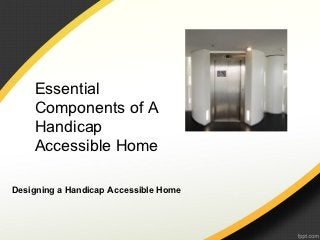
Essential components of a handicap accesible home
- 1. Essential Components of A Handicap Accessible Home Designing a Handicap Accessible Home
- 2. Designing a Handicap Accessible Home • A handicap accessible home is essential for anyone who uses a mobility assistance device such as a wheelchair, cane or walker. Many homeowners also choose to modify their home so that it will be more accessible to friends and loved ones who have limited mobility. When a person decides to create a home that is accessible to everyone, they will also be making sure that everyone is comfortable and safe. Here, are a few ways that a person can get started designing a home that will be handicap accessible without sacrificing functionality.
- 3. Kitchen Areas • Wheelchairs and other mobility devices can make it hard for a person to reach the sink. This can be helped by removing the cabinet doors so that a person will have more room below the sink. Faucet handles and knobs should be changed to a lever style that will be easier for a person with limited hand mobility to turn.
- 4. Kitchen Areas • Although lowered cabinets are ideal, this may not be possible for every homeowner. Instead, objects that are frequently used should be moved to the lower shelves so that they will be more accessible.
- 5. Bathrooms • Getting in and out of the bathtub is not only difficult, but it can be dangerous for a person with limited mobility. Handicap accessible showers are a better option that can make it possible for a person to bathe without having to step over a ledge.
- 6. Bathrooms • It is also ideal to include tread on any slippery surfaces so that the risk of falls will be reduced. Installing pedestal sinks with levered handles can also make it easier for a person to wash their hands. Grab bars should also be installed in any areas that a person may need to have extra support such as in the bathtub or near the toilet.
- 7. Entrances and Doorways • Although raised entrances create an impressive look for the exterior of a home, they can be very difficult for a person with handicaps to cross over. A ramp can help to smooth the way for a person with limited mobility. Some people choose to have a permanent ramp installed while others use a temporary ramp that can be removed when it is not needed.
- 8. Entrances and Doorways • It is also important for doorways to be wide enough to accommodate a wheelchair. Simple modifications such as using expandable hinges or installing French doors can help a person to widen the doorways.
- 9. Storage Areas • Closets, pantries and other storage areas should also be included in the design plans for handicap accessibility. When possible, lowered shelves should always be included in these areas. If an area is being designed for a specific person, then their ability to reach and bend should be considered. Then, items that they use often can be placed in areas that are easier for them to reach.
- 10. • In any handicap accessible home, a person can include a variety of unique features to make things easier. Many people also use technology to enhance accessibility such as timers to turn off lights, social media updates to let others know how a person is doing and electronic security. By combining safety features with accessibility modifications, a person can ensure that a person with limited mobility will be comfortable and secure.
- 11. Further Information… • LG Accessible Living Solutions is a leading provider of wheelchair & handicap accessible shower stalls & accessories. Visit us today at http://www.lgaccessibleshowers.com/ to learn more.